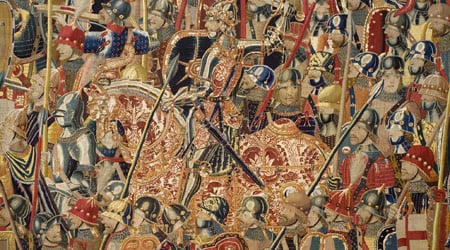The Invention of Glory, Afonso V and the Pastrana Tapestries

Exhibition of the four late-fifteenth-century Flemish tapestries known as The Pastrana Tapestries from the Collegiate Church of Pastrana in Guadalajara, Spain.
The recently restored Pastrana tapestries are some of the finest examples of Gothic tapestries in the world. In the late 15th century the king of Portugal, Afonso V (1432–1481) likely commissioned a set of four monumental (each one measures 12 by 36 feet) tapestries commemorating his conquest in 1471 of the Moroccan cities of Asilah and Tangier, strategically located near the entrance to the Strait of Gibraltar.
Exquisitely rendered in wool and silk threads and woven by Flemish weavers in Tournai, Belgium, the tapestries teem with vivid and colorful images of knights, ships, and military paraphernalia set against a backdrop of maritime and urban landscapes. The tapestries are highly unusual for their depiction of contemporary events rather than scenes from ancient or biblical history. In the tapestries, the misery of warfare is minimized. The designer reinvented the event with the heroic image of Afonso and his court and the ideals of chivalry in mind.
Passchier Grenier, the outstanding tapestry merchant of the day, almost certainly carried out the royal commission. His illustrious clients included crowned heads of Europe and the dukes of Burgundy for whom Grenier’s workshops in Tournai produced tapestries in the same style and technique as those made for Afonso V.
The tapestries have been the property of the Collegiate Church of Our Lady of the Assumption in Pastrana, Spain, since the 17th century. Because of their outstanding quality and historical significance, the Spanish government listed them among their cultural patrimony to be safeguarded in the event of war. In 1939 they were evacuated along with paintings from the Prado to Geneva, where they remained until their return to Spain at the end of the hostilities.
The Pastrana tapestries recently returned to Belgium, for complete conservation by the Royal Manufacturers De Wit in Mechelen (Malines). Over the years, the tapestries suffered various forms of damage: moths ate away many of the wool threads, leaving large holes; iron mordants used in the dyeing process corroded some of the dark-colored wool; dirt and stains obscured the original bright colors; and prolonged exposure to light caused fading and severely weakened the silk threads. Now fully restored, the tapestries promise to be a revelation for scholars and the general public alike, and the exhibition in Washington one of the truly extraordinary museum events of the year.
The exhibition is organized by the National Gallery of Art, Washington, and the Fundación Carlos de Amberes, Madrid, in association with the Embassy of Spain, the Spain-USA Foundation, and the Embassy of Portugal and with the cooperation of the Embassy of Belgium and the Embassy of Morocco in Washington, DC.
The exhibition is made possible through the generous support of the Government of Spain, the Government of Portugal, Ministry of Foreign Affairs, Instituto Camões, and the Government of Belgium, Ministry of Foreign Affairs.
The conservation of the tapestries was undertaken at the initiative of the Fundación Carlos de Amberes, with support from the Inbev-Baillet Latour Fund, the Fundación Caja Madrid, the Region of Castilla-La Mancha, the Provincial Council of Guadalajara, and the Diocese of Sigüenza-Guadalajara / Church of Our Lady of the Assumption.
- Heritage
- Salem, MA
- Oct 27, 2012 – Dec 31, 2012
Venue
East India Square, 161 Essex Street, Salem, MA 01970-3783
View on Google MapsPhone
978-745-9500
More information
Credits
Support provided by the East India Marine Associates of the Peabody Essex Museum.